TL;DR of the 10 Tips to Get More Reviews
1. Make it Easy to Leave a Review: Simplify the review process by listing your business on relevant review sites (e.g., Google, Yelp) and adding clear calls-to-action (CTAs) on your website to encourage customers to leave feedback.
2. Display Reviews on Your Website: Showcase existing customer reviews on your site to provide social proof, enhance SEO with fresh content, and encourage others to share their experiences.
3. Send Purchase Follow-Up Emails: After a purchase, send timely follow-up emails requesting a review while the customer’s experience is still fresh, maximizing response rates.
4. Use Incentives to Increase Customer Reviews: Offer incentives like discounts, coupons, or entry into contests to motivate customers to write reviews, fostering repeat business.
5. Use Product Review Tools to Manage Reviews: Implement review management tools (e.g., Yotpo, Kudobuzz) to collect, manage, and display reviews efficiently across different platforms.
6. Make Reviews Count: Demonstrate to customers how their reviews benefit them, such as through personalized recommendations or improved services, making them feel valued.
7. Include a Call-to-Action on Physical Materials: Add QR codes or review prompts on physical items like receipts, packaging, or inserts in orders to encourage customers to leave reviews.
8. Post to Social Media: Share positive reviews on your social media channels to highlight customer satisfaction, engage your audience, and encourage others to share their feedback.
9. Pay Attention to Negative Reviews: Address negative reviews promptly and professionally, apologizing and offering solutions to resolve issues, which can turn dissatisfied customers into loyal ones.
10. Ask for Reviews Directly: Simply ask customers for reviews in person, via email, or on social media, focusing on the timing when they are most satisfied to increase the likelihood of positive feedback.
Do you want to learn how to get more reviews?
Whether you run a local business or have customers around the world, the power of a review cannot be overstated. Reviews have the unique ability to shape perceptions and influence decisions.
Given how much shoppers rely on reviews, you’d think they would put more value on writing their own, but on average, they don’t. 92% of consumers read online reviews, but only 6% write them.
In this guide, I will share tips on how to get more reviews and not just that but also how to increase the quality of your reviews, transforming your online presence.
Let’s get started.
Related ContentSocial Proof Statistics: Powerful Facts That Will Help You Boost Your Brand
Understanding the Value of Reviews
Let’s go over a couple of benefits of obtaining business reviews:
The SEO and Visibility Boost
Reviews do more than just reassure potential customers; they’re a cornerstone of your online visibility. Your review quantity and quality are SEO ranking factors for search engines like Google.
More reviews, especially positive ones, signal to search engines that your business is trustworthy and relevant, potentially boosting your visibility in search results.
Building Trust and Credibility
Imagine you’re choosing between two local cafes you’ve never visited. One has numerous positive reviews detailing the cozy ambiance and exquisite coffee, while the other has few or no reviews. Which would you choose?
If you’re like most consumers, you’d opt for the former. Reviews are a form of social proof, offering reassurance to potential customers that they’re making the right choice.
How To Get More Reviews
- Make it Easy to Leave a Review
- Display Your Reviews on Your Website
- Send Purchase Follow Up Emails
- Use Incentives to Increase Customer Reviews
- Use Product Review Tools to Manage Reviews
- Make Reviews Count
- Include a Call-to-Action on Physical Materials in Each Order
- Post to Social Media
- Pay Attention to Negative Reviews
- Ask for Reviews Directly
1. Make it Easy to Leave a Review
As a business owner, you should make sure your business is listed on all relevant review sites. Different platforms cater to different audiences and industries, so it’s crucial to identify where your customers are most active.
Google My Business, Google Business Profile, Yelp, and TripAdvisor are key. Make sure your profiles are complete and appealing, with up-to-date information and high-quality images that invite engagement.
Your website should also encourage reviews. Add clear CTAs such as “Leave Us a Review” on your homepage and post-purchase pages.
The easier you make it for customers to leave a review on your products, the more likely you are to actually get reviews. People aren’t going to go 4 levels deep on your site and then search for their product in a database in order to leave a review.
Take a cue from Beardbrand and make your reviews easy to find and easy to leave. Every product page has a section for reviews:
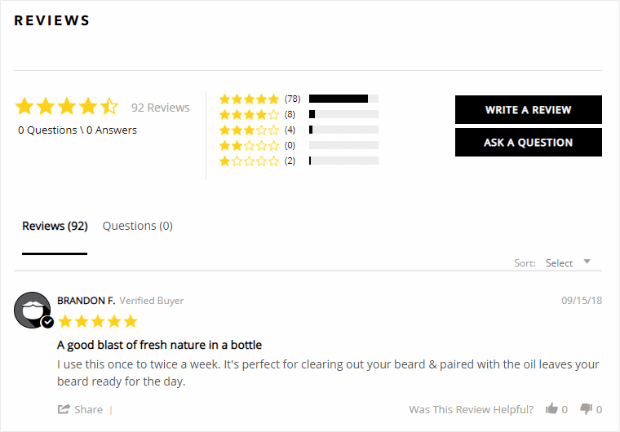
You can do this with an app like Yotpo Social Reviews. See a couple more review management tools in #5.
Alternately, if you’re using WordPress, you can make a user review form with WPForms. This option may be more cost-effective, plus you can use the plugin to build contact and other forms on your website.
2. Display Your Reviews on Your Website
As you can see from the Beardbrand image above, they include their reviews on their website too. This serves a few purposes.
- Lots of social proof. Other shoppers can see that people are enjoying this product.
- More original content is great for SEO and rankings.
- Shoppers can share reviews, ask questions, and mark other reviews and helpful or unhelpful.
If you’re asking for reviews, share them on your site. What else were you going to do with them, anyway?
Embedding a plugin like TrustPulse to showcase existing reviews can be a game-changer, as it not only displays social proof but also makes leaving a review seem like joining an esteemed group of satisfied customers.
If the reviews are particularly glowing or entertaining, share them on social media platforms or highlight them in some way. And, definitely give a shout out to the customer.
Don’t forget, there are probably some awesome testimonials about your company on social media already.
You can easily pull reviews from Twitter and display them on your site with a plugin like Smash Balloon.
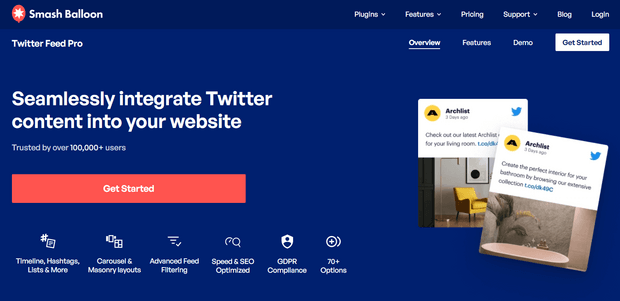
Smash Balloon’s Custom Twitter Feeds Pro lets you seamlessly integrate a Twitter feed into your website. The best part is that it gives you the ability to create a feed of tweets that mention your account or use your branded hashtag.
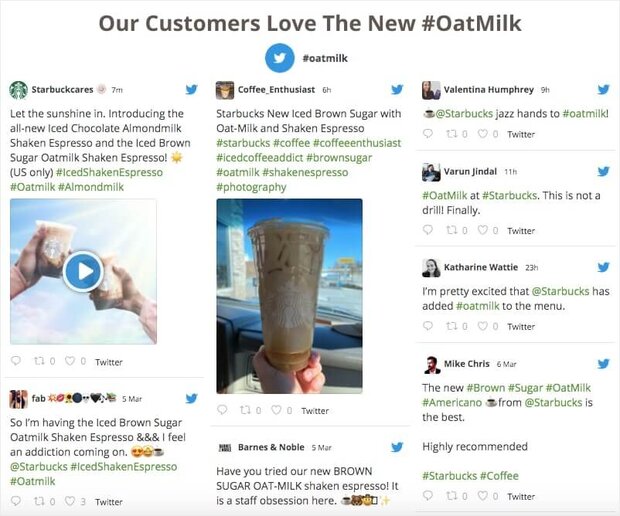
This is the perfect way to show off the love your customers have for your business and encourage your website visitors to tweet about you too.
Similarly, you can also embed Google reviews on your websites and have review sites have your product or service reviewed.
3. Send Purchase Follow Up Emails
Post-purchase email requests for reviews have an 8% response rate, making them the best way to get reviews.
To get the best response, try to send your review request email within a week of the purchase to take advantage of those good feelings that shopping releases. ? Also, according to research done by Yotpo, you’re likely to get your best response on Saturday, so keep that in mind.

New to email marketing? Here’s our step-by-step guide to running an email campaign.
4. Use Incentives to Increase Customer Reviews
Coupons, discounts, and other rewards are great ways to encourage your customers to leave reviews. Incentives also have the added bonus of encouraging repeat sales.
Loyalty programs are a great way to track and distribute your incentives. If you have a loyalty program, you can incorporate points for reviews and share reviews on social media.
Contest entries are another great incentive you can offer in exchange for a review.
And remember that social mentions can be pretty cool rewards too. Just don’t forget to tag the customer.

A quick aside: incentives are a great tool to increase customer feedback and a fine eCommerce marketing strategy overall, but make sure that you’re not just rewarding the positive reviews. Nobody wants negative reviews, but we’ll talk about how to deal with them in a minute.
5. Use Product Review Tools to Manage Reviews
Several product review tools are available to help you manage your reviews. You can find one that works for you, whichever eCommerce platform you use.
Let’s talk about a few of them.
Kudobuzz
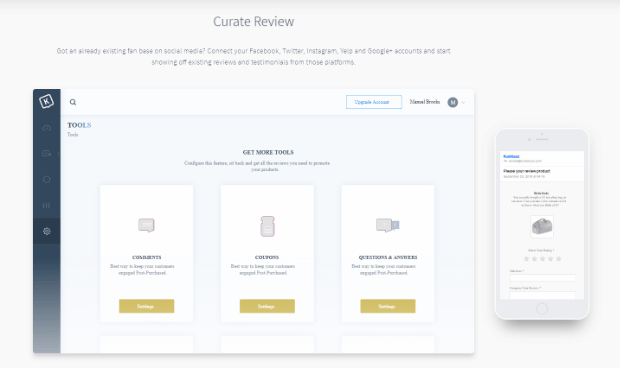
Kudobuzz helps you collect reviews from customers in a few different ways:
- Sending out post-purchase email requests
- Collating posts and reviews from Facebook, Twitter, Instagram, Google+, and Yelp
- Creating broadcast links that you can send to request reviews
The content is then displayed on the Kudobuzz dashboard, and you can decide what you want to use and where.
Yotpo
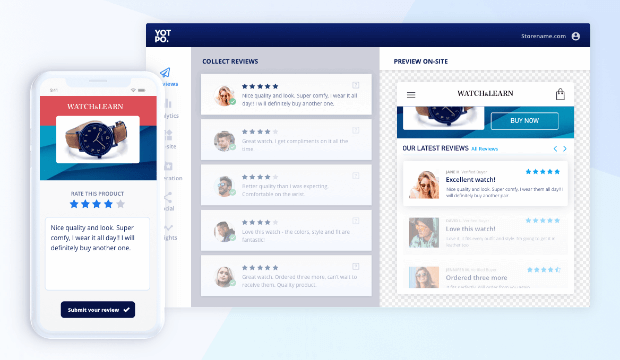
Yotpo is a review management solution that shines in its analytics and reporting. You can use the reporting to make data-driven decisions to improve marketing strategy, generate reviews, and get quality traffic.
Product Reviews by Shopify
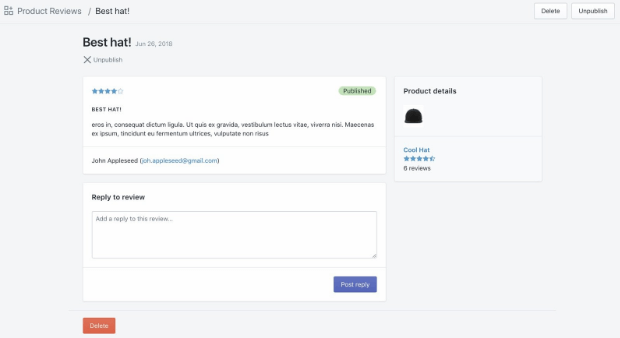
Product Reviews by Shopify is perfect for those of us who don’t have coding knowledge but still want a great-looking product reviews feature on our eCommerce sites.
Customers can engage with you and with each other within the product reviews, making it possible for you to respond to reviews. Your customers can even ask each other questions about the fit and feel of the product, which can result in increased social proof.
6. Make Reviews Count
We’ve already talked about incentives; people like getting something for giving something. One of the things that people get from Amazon for their reviews is recommendations. Amazon uses your reviews to show you other products you may like later.
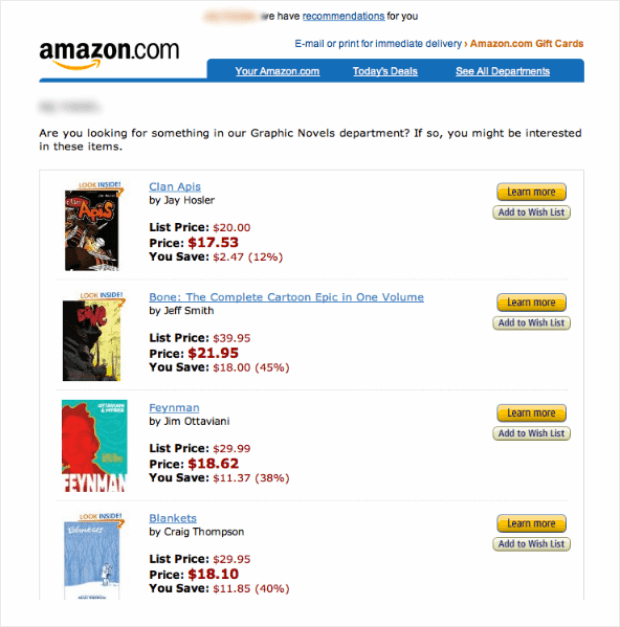
Basically, you’re reviewing things to help the future find more things to buy.
7. Include a Call-to-Action on Physical Materials in Each Order
If you include paper invoices or other marketing materials in your shipments, you can create and include a call-to-action with a QR code. Then, use WPForms to create a mobile review form to capture reviews. When the customer uses the QR code from their phone, they’re taken to the form and can submit a review.

Not sure how to get them to scan the QR code? Learn how to create the perfect call to action here.
8. Post to Social Media
Sharing positive reviews on social media has sparked conversations and encouraged others to leave their feedback. It’s a way of showing appreciation for happy customers and subtly inviting others to share their experiences.
Engaging with your audience through polls or questions about their customer experiences can also prompt reviews.
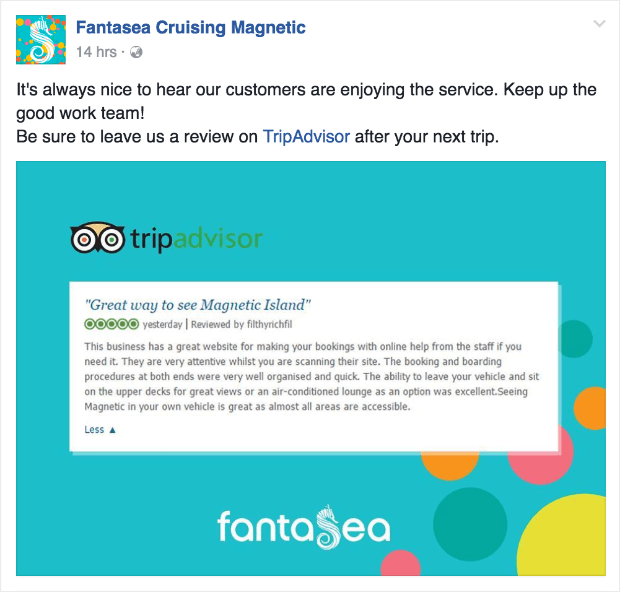
9. Pay Attention to Negative Reviews
You may think the best thing to do with negative reviews is ignore them, but it definitely isn’t. Here’s a good process to follow for negative reviews:
- Apologize.
- Tell the upset customer how to contact you.
- Explain how you’ll make it right.
If you get everything solved and everyone’s happy, ask the customer to write a new review. If you’ve handled everything professionally and compassionately, you may have gained a lifelong customer from a formerly bad review.
10. Ask for Reviews Directly
One of the most effective strategies is simply asking customers for reviews. Whether in person, via email, or social media, making a direct request can significantly increase your review volume.
The key is timing; ask when the customer’s positive experience is fresh in their mind. For instance, after hosting a successful event, send follow-up emails thanking attendees and gently asking for feedback on Google.
You can even utilize your email signature to obtain a review or have CTAs placed on your website, redirecting to your Google business profile.
Automation tools have been a lifesaver in managing review requests. Platforms like Trustpilot or Yotpo automate the process of sending review requests after a purchase. This not only saves time but also ensures that no customer is overlooked.
That’s it! Now, you have 10 great ways to get more product reviews on your website and increase social proof.
Actively seeking and managing reviews is an ongoing process that can dramatically impact your business. It’s about more than just increasing numbers; it’s about building relationships, trust, and an online reputation for excellence.
By implementing the tips outlined in this guide, you can create a robust review ecosystem that fuels business growth and customer loyalty.
Remember, every review is a chance to learn, improve, and celebrate your successes. So, start today, and watch as your collection of reviews transforms your business.
How To Get More Reviews – FAQs
1. How to Get More Google Reviews?
- Ask Customers Directly: After a transaction or service, directly ask your satisfied customers to leave a review. Make it easy by sending them a link directly to your review page.
- Email Follow-ups: Incorporate requests for reviews in your follow-up emails. This can be effective especially after a customer has confirmed satisfaction with your product or service.
- Utilize Your Website: Add a call-to-action on your website that directs customers to your Google review page.
- Incentives: While Google discourages offering incentives for reviews, ensuring excellent service and experience can naturally encourage customers to leave positive feedback.
- Respond to Existing Reviews: Show that you value feedback by responding to current reviews, which can encourage others to leave their own.
2. How to Get More Reviews on Amazon?
- Automated Email Campaigns: Use Amazon’s “Request a Review” button or automated email services to ask customers for feedback about 5-30 days post-purchase, which is the optimal time when the experience is still fresh in their minds.
- Amazon Vine Program: If eligible, enroll in Amazon’s Vine program, where trusted reviewers are provided with your product for honest reviews.
- Provide Excellent Customer Service: Quick responses to customer inquiries and resolving issues can lead to higher rates of positive reviews.
- High-Quality Product Listings: Ensure your product descriptions, images, and information are clear and high-quality, reducing negative reviews due to misunderstandings.
3. How to Get More Yelp Reviews?
- Yelp Signs and Stickers: Display Yelp branding in your place of business to remind customers that they can rate their experience on Yelp.
- Personalized Requests: After a service, personally encourage customers to share their experience on Yelp without offering incentives, as this is against Yelp’s policies.
- Social Media Integration: Share your Yelp page on your social media platforms to increase visibility.
- Respond to Reviews: Just like with Google, responding to reviews on Yelp can also encourage others to leave feedback, showing that you value customer input.
- Optimize Your Yelp Business Page: Make sure your business information is accurate, and consider posting updates or using features like Yelp Check-In Offers to engage with customers.











Add a Comment